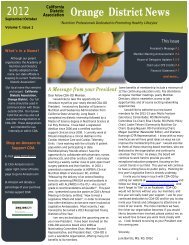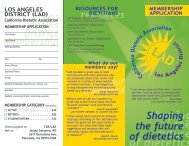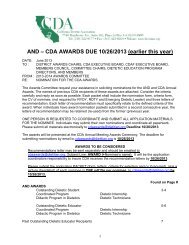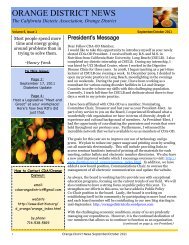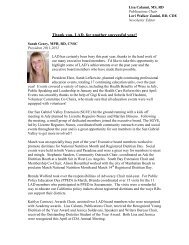The Selection and Care of Enteral Feeding Tubes
The Selection and Care of Enteral Feeding Tubes
The Selection and Care of Enteral Feeding Tubes
Create successful ePaper yourself
Turn your PDF publications into a flip-book with our unique Google optimized e-Paper software.
<strong>Enteral</strong> <strong>Feeding</strong> Tube Decision Tree<br />
Short Term<br />
Less than 3 to 4 weeks<br />
No Aspiration Risk or<br />
Gastric Problems<br />
Nasogastric Tube<br />
<strong>Enteral</strong> Nutrition Needed<br />
Long Term<br />
Greater than 3 to 4 weeks<br />
Nasoenteric Tube Enterostomy Tube<br />
Aspiration Risk or<br />
Delayed Gastric<br />
Emptying<br />
Nasoduodenal or<br />
Nasojejunal Tube<br />
No Aspiration Risk<br />
or Gastric Problems<br />
Gastrostomy Tube<br />
Guenter, P., Silkroski, M. 2001. <strong>Enteral</strong> <strong>Feeding</strong> Access Devices. Tube <strong>Feeding</strong> Practical Guidelines <strong>and</strong> Nursing Protocols.<br />
Aspiration Risk or Delayed<br />
Gastric Emptying [patient<br />
condition dependent ]<br />
Jejunostomy or<br />
Combined<br />
Gastrostomy-<br />
Jejunostomy<br />
Nasoenteric Tube Complications<br />
Sinusitis<br />
Epistaxis<br />
Dysphasia<br />
Dislodgement<br />
Tube occlusion<br />
Pulmonary aspiration<br />
Nasopharyngeal discomfort<br />
Erosion <strong>of</strong> the nasal septum<br />
Migration <strong>and</strong> displacement<br />
Iyer, K.R., Crawley, T.C. Complications <strong>of</strong> <strong>Enteral</strong> Access. Gastrointestinal Endoscopy Clinics <strong>of</strong> North America, 17 (2007) 717-729.<br />
Enterostomy Tube Complications<br />
Infection<br />
Pressure necrosis/ulcers<br />
Skin irritation/breakdown<br />
Excessive granulation tissue<br />
Peritubular allergic reactions<br />
Tube deterioration<br />
Tube occlusion<br />
Tube displacement<br />
Guenter, P. tube Chap 7. 2001. tube <strong>Feeding</strong>: Practical Guidelines <strong>and</strong> Nursing Protocols. CREST. April 2004. Guidelines for the Management <strong>of</strong> <strong>Enteral</strong> Tube <strong>Feeding</strong> In Adults.<br />
31<br />
33<br />
35<br />
Complications<br />
Associated with<br />
<strong>Enteral</strong> <strong>Feeding</strong><br />
<strong>Tubes</strong><br />
Nasoenteric Tube Complications<br />
Nasoenteric feeding<br />
tubes should NOT be<br />
used for periods<br />
longer than 4 weeks.<br />
O’Keefe, S.J.D.Na.Rev.Gastroenterol.Hepatol,6,210 (2009)<br />
<strong>The</strong> Joint Commission<br />
Sentinel Event Alert: Issue 36 – April 3, 2006<br />
“Tubing misconnections – a persistent <strong>and</strong> potentially deadly occurrence”<br />
Reported cases to Joint Commission:<br />
eight deaths <strong>and</strong> one instance <strong>of</strong> permanent<br />
loss <strong>of</strong> function; 7 adults <strong>and</strong> 2 infants<br />
“tube feeding formula is accidentally connected to intravenous<br />
or other lines or catheters for which it was not intended”<br />
<strong>The</strong> Joint Commission Sentinel Event Alert, Issue 36, April 3, 2006.<br />
32<br />
34<br />
36



